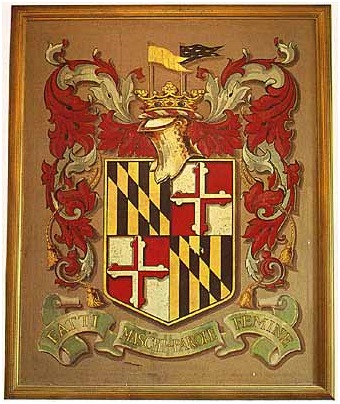I have been watching a small local colony of butterflies for the last five years. In 2007 and 2008, they thrived, but in 2009 there came a flood.
I had but little hope that the colony would survive. Still, as Alexander Pope said, “Hope springs eternal in the human breast.” 1
The Barons of Baltimore were Calverts. 2 The Calvert family crest is a striking confection of black, gold, and scarlet, and it apparently made quite an impression on our earliest naturalists. 3

There is, of course, the resplendent Baltimore Oriole (Icterus galbula), the State Bird of Maryland, and there is also the Baltimore Checkerspot (Euphydryas phaeton), the State Insect of Maryland. Both, it would seem, named for their bright black and orange colors.
I grew up in Maryland, but, alas, I never saw her State Insect. On 27 May 2007, however, I came across an astonishing bright orange caterpillar with black spikes—the final instar of the Baltimore Checkerspot. Early instar Baltimore Checkerspots feed in webs on Turtlehead (Chelone glabra) until they go into diapause for the winter.
The later instars that emerge in the spring seem to eat almost anything green—not picky at all.
Turtlehead is one of many plants that contain glycosides. Some caterpillars quickly pass the glycosides through their systems, others—such as Baltimore Checkerspots—build up (sequester) the glycoside level in their bodies, which makes them unpalatable, a trait that they pass on to the adult butterfly. 4 The bright orange and black patterns of the caterpillar and adult are considered warning coloration, and I suspect this applies to the bright orange spots on the chrysalis as well.
Of interest, several researchers have noted that Baltimore Checkerspots have recently begun to feed upon English Plantain (Plantago lanceolata), an introduced species that you probably have growing in your yard. English Plantain contains similar glycosides. Female Checkerspots still prefer Turtlehead for oviposition, and the larvae that feed on Turtlehead gain more weight and mature more quickly. 5
In early June of 2007, I found some caterpillars making the “J” that usually signifies that a caterpillar is ready to become a chrysalis.
I kept checking back, and eventually I found several of the extraordinarily ornate chrysalides. 6
Beginning on 8 June, dozens of adults emerged. In 2008, I saw the first caterpillars on 2 June, and the adults emerged on 21 June.
The spring of 2009, looked to be a repeat of ’07 and ’08, by late May, there were dozens of caterpillars.
Then came the flood. When the waters receded on 31 May, I found but one—and he wasn’t in good shape. I saw no adults that year.
Hope waned.
In 2010, I saw no caterpillars, but I did see one worn adult in late June about a half a mile away.
That August, however, I found a nest of early instar caterpillars feeding in a web on a Turtlehead about 100 yards south of where I normally found caterpillars.
The following spring, on 29 May 2011, I found one caterpillar. Then came the flood—again. I saw no adults last year.
Hope faded.
This year I made several visits throughout May, and I found no caterpillars.
Hope dimmed to the merest glimmer.
But hope never died. On 14 June, at the end of the day, I came across a freshly emerged adult. The next day, I saw two adults chasing at the other site a half a mile away.
Yep, hope, to quote Pope, springs eternal, or perhaps, in this case, the poet Burns is more apropos:
“Hope springs exulting on triumphant wing.” 7
- Alexander Pope, “An Essay on Man”
- George was the first Baron, Cecil the second. It is Cecil who was granted the charter for what would become the state of Maryland.
- Crest illustration “Exploration and Settlement,” Newfoundland and Labrador Heritage, http://www.heritage.nf.ca/exploration/default.html#baltimore
- Marko Nieminen et al, “Effect of Iridoid Glycoside Content on Oviposition Host Plant Choice and Parasitism in a Specialist Herbivore.” Journal of Chemical Ecology, Vol. 29, No. 4, April 2003. Available online at http://www.eeb.cornell.edu/sdv2/saskya%20www/PDFs%20of%20papers/Nieminenet%20al-iridoids03.pdf [Accessed 18 June 2012]. This research was conducted in Finland based on the Glanville Fritillary, Melitaea cinxia.
- M. Deane Bowers et al, “Early Stage of Host Range Expansion by a Specialist Herbivore, Euphydryas Phaeton (Nymphalidae).” Ecology, 73(2), 1992, pp. 526-536. Available online at http://evolution.binghamton.edu/evos/wp-content/uploads/2011/03/Bowers-et-al.-1992-E-phaeton-range-expansion.pdf [Accessed 18 June 2012]. According to Bowers et al, “Chelone glabra contains the iridoid glycoside, catalpol, and sometimes aucubin may be present as well….Plantago lanceolata contains two iridoid glycosides, primarily aucubin, with, usually, smaller amounts of catalpol.”
- The plural of chrysalis is either chrysalises or chrysalides (rhymes with price of bitties). I prefer chrysalides because I have some pity on anyone who may need to read chrysalises out loud: a most dissonant word.
- Robert Burns, The Cotter’s Saturday Night.
